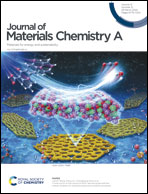Integrated copper host/current collector engineering for enhanced sodium storage in SeS2 electrodes†
Abstract
Selenium disulfide (SeS2) emerges as a promising candidate for sodium storage electrodes, boasting a high theoretical specific capacity and superior electrical conductivity compared to sulfur. Nonetheless, the cycling performance of SeS2 is significantly compromised by its limited electrical conductivity and the shuttle effect of sodium polysulfides/polyselenides (NaPSs/NaPSes). To overcome these obstacles, we introduce a copper host/current collector co-engineering strategy to optimize the SeS2 electrode's electrochemistry, thereby enhancing its stability and reaction kinetics. Ex situ characterization offers profound insights into the synergistic interaction between the Cu@CNT host and Cu foil with NaPSs/NaPSes during cycling, which effectively stabilizes NaPSs/NaPSes and forms a robust Cu/electrode interface. As a result, the SeS2 electrode undergoes a transformation into NaPSs/NaPSes and conductive Cu1.95S/Cu1.8Se composites, substantially bolstering electrode stability and improving charge transfer kinetics. The synergetic effect between the Cu@CNT host and Cu foil endows the SeS2 electrode with exceptional cycling performance (maintaining 100% capacity over 600 cycles) and remarkable rate capability (579 mA h g−1 at 10 A g−1), with minimal Cu corrosion (≤2.5%). The proposed battery system shows immense promise for stable, cost-efficient grid-scale applications.



 Please wait while we load your content...
Please wait while we load your content...